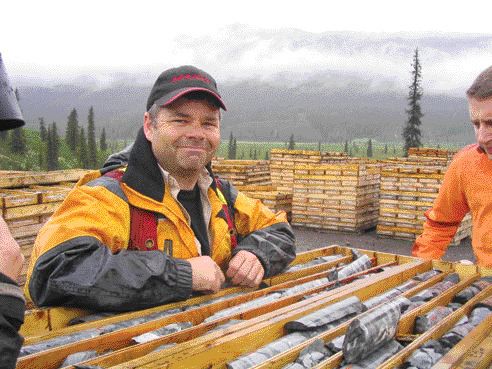Vancouver — Selwyn Resources (SWN-V, SWNLF-O) pumped $25 million into the huge Howard’s Pass project last summer, completing 37,686 metres of diamond drilling in 103 holes. And while the project claims cover lead-zinc discoveries along a considerable 38-km strike length, Selwyn’s decision to narrow its focus to a small segment of the project is paying off.
A steady stream of drill results from Howard’s Pass, an isolated project in the east-central Yukon, are demonstrating the potential for a large-scale deposit with both lower-grade, open-pit targets and higher-grade, underground zones. Selwyn is close to showing that what started as four separate discoveries kilometres distant from one another, called the Don, Don East, HC West, and HC targets, is actually one continuous body of mineralization.
Don Valley is the portion of the Howard’s Pass project covering the current area of interest. At the northwest end of Don Valley sits a deposit called Anniv; at the southeast end lies a deposit known as XY. Until Selwyn arrived in 2005, there had been no drilling in the Don Valley because all previous operators had concentrated on known mineralization at Anniv and XY.
Exploration over the last three years has traced the zinc-lead-mineralized unit, called the Active Member, over the entire 14.6-km length of the valley, discovering five new deposits along the way. Selwyn’s geologists now believe the valley holds a laterally extensive, high-grade core extending from Anniv to XY, with lower-grade mineralization at shallower depths.
An April 2007 estimate pegged total indicated mineral resources in the Don Valley at 15.43 million tonnes grading 4.29% zinc and 1.09% lead, plus inferred resources of 98.45 million tonnes grading 4.62% zinc and 1.22% lead. Results from the summer’s exploration program indicate all of those numbers will grow with the new resource estimate, due out in the spring.
The Don deposit, which is closest to Anniv, hosts a high-grade underground target. Recent deeper drilling yielded the single highest assay of combined zinc-lead mineralization for the entire project in hole 74, which included a 1.3-metre section from 271.8 metres depth grading 46.78% zinc and 17.94% lead. Along strike and at the same elevation, hole 109 returned 20.3 metres true thickness grading 6.6% zinc and 2.69% lead, from 260 metres down-hole.
Along the southeastern margin, towards Don East, hole 120 confirmed expansion potential with 15.8 metres grading 4.53% zinc and 1.62% lead from 276 metres depth, as did hole 124, with 19.7 metres grading 4.11% zinc and 1.45% lead.
Hole 113 returned 2.3 metres grading 8.34% zinc and 2.81% lead from 638 metres down-hole, the deepest intersection in the deposit area. The company believes the deep interval indicates the Don deposit remains open at depth.
Drilling at Don is targeting a 900 by 700-metre area that is modelled to contain some 12 million tonnes of Active Member material, ranging in grade from 7% to 20% combined zinc-lead. The tonnage and grade are derived from a geological model developed from drill results, but do not represent a proven resource.
Moving southeast, Selwyn discovered high-grade mineralization at Don East this summer, defining a new underground target. Hole 106 hit 22.5 metres true thickness grading 8.09% zinc and 1.76% lead from 510 metres depth. The hole was a 1.2-km stepout from the high-grade underground Don target, thus the intercept suggested the continuity of high-grade mineralization from Don to Don East. Following up on that lead, Selwyn collared a hole 230 metres northeast of hole 106 and hit 45 metres grading 4.55% zinc and 1.26% lead from 611 metres in hole 114.
Within the open-pit target at Don East, drills intercepted higher-grade mineralization than previously encountered. Hole 103 returned 15.8 metres true width grading 10.41% zinc and 3.96% lead from 133 metres depth. Slightly deeper, hole 79 intersected two layers of mineralization: 14.8 metres grading 5.35% zinc and 1.87% lead from 167 metres depth, followed by 6.6 metres grading 6.35% zinc and 2.41% lead from 214 metres. The intercepts added confidence that mineralization is continuous between the shallower, open-pit target and the deep underground zone, as well as adding potential tonnage by suggesting another horizon of mineralization.
The summer’s drilling moved the edge of known mineralization at Don East 900 metres closer to the Don deposit. A further 850 metres remains to be drill tested. Selwyn’s models suggest that the Don East deposit could be as large as 55 million tonnes.
Continuing southeast, at the HC West open-pit target, hole 111 returned 16.5 metres of 6.92% zinc and 2.08% lead from 116 metres depth, demonstrating that there is potential for continuity of higher-grade mineralization at open-pittable depths and across larger extents. And hole 112 stepped east 150 metres and hit 8.6 metres grading 8.12% zinc and 2.28% lead from 64 metres depth.
The final step in proving continuous mineralization along the length of the Don Valley is to drill the 1.08-km gap that remains between HC West and HC, to the southeast. For now, exploration is halted for the winter.
Selwyn is also making progress on the permitting side of things. The company spent $3.1 million on engineering and environmental studies over the summer, in preparation for a prefeasibility study slated to get under way early this year.
Metallurgical studies confirmed what was expected: the lack of pyrite in the ore aids recovery of fine-grained zinc and lead sulphide minerals. Zinc grades of 55% to 57% and lead grades of 65% to 70% were readily achieved, with recoveries of 80% for zinc and 75% for lead. Of particular interest was the success of the pre-float of carbon to aid recoveries in the range of 2-4%.
In addition, the combination of low pyrite and carbonate means the rocks are non-acid generating, minimizing the potential for significant environmental impact.
Selwyn has a 52-week trading range of 19.5-90 with 143.7 million shares issued.


Be the first to comment on "Howard’s Pass keeps growing for Selwyn (January 21, 2008)"